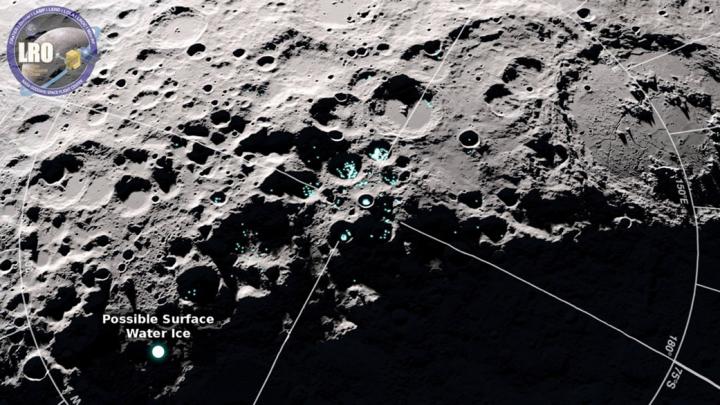

In craters near the south pole of the moon, NASA's Lunar Reconnaissance Orbiter found some bright areas and some very cold areas. In areas that are both bright and cold, water ice may be present on the surface as frost.
Credit: NASA's Goddard Space Flight Center/Scientific Visualization Studio
The new evidence comes from an analysis that combined surface temperatures with information about how much light is reflected off the moon's surface.
“We found that the coldest places near the moon's south pole are also the brightest places–brighter than we would expect from soil alone–and that might indicate the presence of surface frost,” said Elizabeth Fisher, the lead author of the study, published in Icarus. Fisher carried out the data analysis while doing research at the University of Hawai'i at Manoa after earning her undergraduate degree. She is now a graduate student at Brown University.
The icy deposits appear to be patchy and thin, and it's possible that they are mixed in with the surface layer of soil, dust and small rocks called the regolith. The researchers say they are not seeing expanses of ice similar to a frozen pond or skating rink. Instead, they are seeing signs of surface frost.
The frost was found in cold traps close to the moon's south pole. Cold traps are permanently dark areas–located either on the floor of a deep crater or along a section of crater wall that doesn't receive direct sunlight–where temperatures remain below minus 260 degrees Fahrenheit (minus 163 degrees Celsius). Under these conditions, water ice can persist for millions or billions of years.
More than a half-century ago, scientists suggested that lunar cold traps could store water ice, but confirming that hypothesis turned out to be challenging. Observations made by NASA's Lunar Prospector orbiter in the late 1990s identified hydrogen-rich areas near the moon's poles but could not determine whether that hydrogen was bound up in water or was present in some other form. Understanding the nature of these deposits has been one of the driving goals of LRO, which has been orbiting the moon since 2009.
Fisher and her colleagues found evidence of lunar frost by comparing temperature readings from LRO's Diviner instrument with brightness measurements from the spacecraft's Lunar Orbiter Laser Altimeter, or LOLA. In these comparisons, the coldest areas near the south pole also were very bright, indicating the presence of ice or other highly reflective materials. The researchers looked at the peak surface temperatures, because water ice won't last if the temperature creeps above the crucial threshold.
The findings are consistent with another team's analysis of LRO data, reported in 2015. That study compared peak temperatures with ultraviolet, or UV, data from the Lyman-Alpha Mapping Project, or LAMP. Both LOLA and LAMP are able to measure surface brightness without sunlight. LOLA does so by measuring reflected laser light, and LAMP, by measuring reflected starlight and the UV skyglow of hydrogen.
“These findings demonstrate once again the value of studying the moon from orbit long-term,” said John Keller, the LRO project scientist at NASA's Goddard Space Flight Center in Greenbelt, Maryland. “All of this work begins with comprehensive data sets made up of years' worth of continuous measurements.”
Together, the two studies strengthen the case that there is frost in cold traps near the moon's south pole. So far, however, researchers have not seen the same signs near the moon's north pole.
“What has always been intriguing about the moon is that we expect to find ice wherever the temperatures are cold enough for ice, but that's not quite what we see,” said Matt Siegler, a researcher with the Planetary Science Institute in Dallas, Texas, and a co-author on the study.
Water ice and other deposits also have been identified in cold traps near the north pole on Mercury. Though it is the closest planet to the sun, Mercury appears to have up to 400 times more ice than the moon does, by Siegler's estimate. Scientists are still figuring out which scenario is “more normal.”
Another tantalizing question is how old the moon's ice is. If the water was delivered by icy comets or asteroids, it could be as ancient as the solar system and could mark the early delivery of water to Earth and the moon. But if the water was produced by chemical reactions driven by the solar wind, it is much more recent. Or both may be true. There could be eons-old ice deposits buried below ground and newer water at the surface.
In any case, Siegler said, there's enough evidence now to argue for further investigation. Not only could the moon's ice provide resources for exploration, it also might help us understand the origins of Earth's water.
For more information about LRO, visit: http://www.












